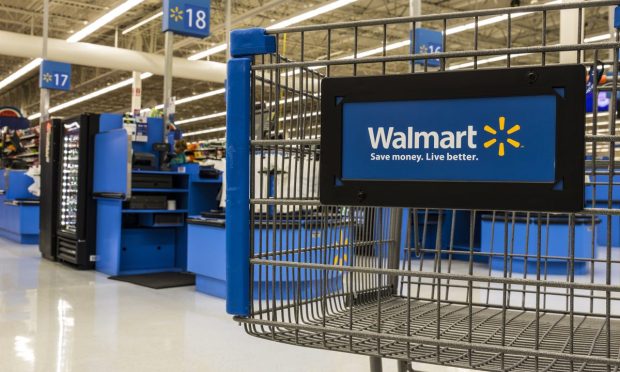AMZN vs WMT Weekly: Rivals Aim to Deliver Groceries That Many Consumers Can’t Find

Just 345 days to go until Christmas (!) but the nation’s retail leaders were able to find time to focus on a different problem this week. Specifically, procuring the hard-to-get grocery and COVID-linked items that consumers want at a time when shelves are looking increasingly bare.
They got through Black Friday. Managed Cyber Monday. Pushed hard through Christmas and hung tough amid omicron. And while Amazon and Walmart have continued to find a way to navigate an endless stream of supply chain-related headwinds, the new year has brought with it a new set of challenges, albeit with more than a little dose of deja vu.
While the two retail titans have not said much about the current bout of shortages that are causing growing gaps in grocery store shelves across the country, they are certainly not immune from the problem.
“We are seeing pockets of lower than normal availability in some communities on some items, depending on what’s happening in the local area,” Walmart Global Communications Director Lauren Willis told KENS TV in San Antonio earlier this week. “We will continue to keep a close eye on product availability and work with our supply chain to help meet customer demand.”
To that point, Walmart and Amazon’s size, buying power, warehousing, logistical capabilities and clout with manufacturers and suppliers will clearly give them procurement advantages that would not be available to smaller players. And yet, no amount of money can make pallets of cat food or cream cheese, or home test kits magically appear.
As much as the first round of consumer goods shortages in the early days of the pandemic eventually subsided, it took months for the supply of things like toilet paper, cleaning wipes and hand sanitizer to normalize to the point where in-store rationing rules could be lifted.
But unlike the first or second span of grocery disruptions, this time — not unlike the virus variant itself — things feel different, more widespread and harder to predict who and where the supply crunch will strike next.
In addition, the fact that this is happening at the very time Amazon and Walmart are both looking to dial up their grocery delivery offerings, could turn those efforts into a make or break issue for whichever player is able to actually deliver the goods … or cat food, as the case may be.
To Fridge or Not to Fridge
As much as Walmart has just announced plans to make its in-fridge delivery service available to 30 million homes, it remains to be seen how the public embrace and demand for such an offering actually plays out. For those busy, connected consumers who may want groceries delivered but balk at the notion of a stranger letting themselves into their home to put food in their refrigerator, Walmart’s delivery option 2 announced this week might provide a less intrusive alternative. Instead of bringing the food inside customers’ homes, or leaving it sitting on the step with risk of spoiling, Walmart’s new pilot of HomeValet’s Smart Box might be the ideal solution.
“Beginning this spring, participating customers in Bentonville, Arkansas, will be able to receive deliveries from their local Walmart directly into a temperature-controlled HomeValet-powered smart box placed outside their home,” Tom Ward, SVP of customer product, Walmart U.S. said in a blog post Tuesday.
These remote controlled, digitally locking coolers give customers the “ability to receive secure, contactless deliveries with the peace of mind knowing their grocery items will stay fresh,” Ward added, addressing one of the most common complaints about at-home food delivery head-on.
Or in the words of HomeValet: “Don’t wait for deliveries, let them wait for you.”
For Amazon Fresh and Whole Foods, perishable food delivery is still being done via refrigerated trucks and two-hour time windows for drop-off … at least for now.
Shop by Diet
But wait, there’s more … Walmart’s new “Shop by Diet” tool powered by Nutrition as a Service provider Sifter was unveiled this week, to help the estimated 200 million Americans with special dietary requirements, and another 85 million who have allergy issues find the foods and recipes they need.
Whether you’re into Paleo, Pegan or Pescatarian diets, eat only Fair Trade, Kosher or Gluten-free, the list of 130 dietary drill-downs is extensive and falls under five major search categories, including: Lifestyle Diets, Responsible Practices, Health or Medical Diets, Allergens & Concerns, and Compatibility with Medication.
“Partnering with Walmart to support customer wellness is exciting for everyone at Sifter,” said Co-founder Andrew Parkinson, who with his brother founded Peapod in 1989 before selling it to Ahold in 2001. “Walmart’s Shop-by-Diet tool will help millions of its customers better manage their health through diet and nutrition,” he added, noting Sifter’s passion for making healthy eating easy for everyone.